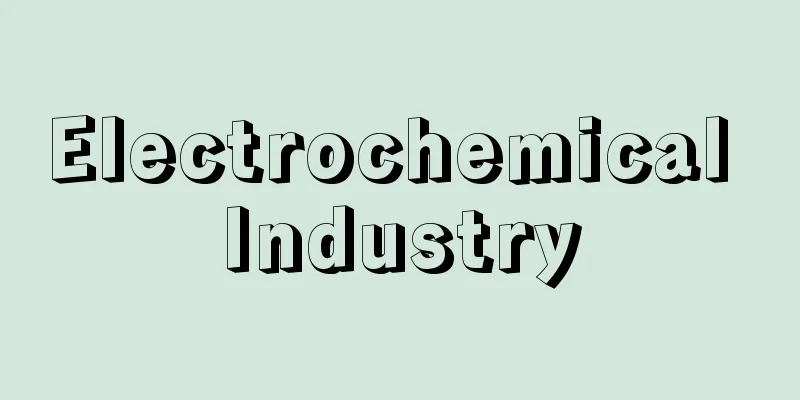Electrochemical Industry

|
It refers to the electrolytic industry that uses electrochemical reactions and the electrothermal industry that uses electric furnaces, particularly the carbide industry. It also includes industries related to battery manufacturing, interfacial electrochemistry, and discharge chemistry. Specifically, the main businesses are the production of ammonia, caustic soda (sodium hydroxide), and calcium carbonate nitrogen through aqueous solution electrolysis and molten electrolysis, electroplating, smelting of ferroalloys, and the manufacture of artificial graphite. The primary characteristic of the electrochemical industry is that it consumes a large amount of electricity, so energy costs account for a high proportion of the cost structure, and in order to reduce this, there have been attempts to operate factories using private hydroelectric power generation, etc. Since the invention of the Daniell cell in 1836, research into batteries has emerged as a major area of electrochemistry. Electroplating was put to practical use based on battery research, and in 1869, an electrolytic smelting method using copper electrolysis was invented, leading to full-scale electrolytic refining of copper and aluminum. Not only the electrolytic smelting of non-ferrous metals such as copper and aluminum, but also the electrolytic soda business, which produces caustic soda, chlorine, and hydrogen by electrolyzing salt water, came to occupy a central position in the electrochemical industry. Chlorine is consumed directly as a gas, and is also manufactured as chlorides such as liquid chlorine, hydrochloric acid, and sodium hypochlorite. The manufacturing process for caustic soda, chlorine, etc., first shifted from the Leblanc process to the ammonia process and then the diaphragm process. Furthermore, in Japan, the production capacity of the salt electrolysis process exceeded that of the ammonia process in 1953 (Showa 28). The expansion of caustic soda production was due to a sudden increase in chlorine demand due to the domestic production of hydrochloric acid for seasonings, bleaching powder for paper and pulp, liquid chlorine, polyvinyl chloride resin for pesticides such as DDT and BHC, and vinylidene chloride. Mercury electrolysis facilities increased because it had fewer impurities, better product quality, and lower cost than the diaphragm process. However, in 1973, the government decided to switch to non-mercury processes due to health hazards, and the ion exchange membrane process began to gain popularity. On the other hand, another major business area of the electrochemical industry is the carbide industry. At the end of the 19th century, the industrialization of carbide and calcium carbonate was pioneered. In Japan, the manufacture of carbide began in 1900 (Meiji 33). The fertilizer calcium carbonate was manufactured as a derivative from carbide, which was used in acetylene lamps. Although calcium carbonate was a major product for a while after the Second World War, the diversification of fertilizers progressed with the rationalization of the ammonium sulfate industry, and its demand has plateaued. In response to this, the demand for acetylene derived products such as polyvinyl chloride resin, vinylidene chloride, and vinyl acetate increased, leading to an increase in the demand for acetylene obtained from carbide. Rationalization and modernization were required to respond to the change in the demand structure, and the modernization of the carbide industry's facilities was promoted. In 1952, Nippon Carbide Industries Co., Ltd. completed the world's first sealed electric furnace, which led to the effective use of carbon monoxide, a by-product. Until then, carbide furnaces were open type. After that, carbide manufacturers adopted closed electric furnaces one after another, and the furnaces became larger, more automated, and more streamlined, improving work efficiency. Carbide melted in electric furnaces led to the expansion of the market for acetylene-based organic chemicals such as acetic acid, vinyl acetate, and vinyl chloride for building materials and adhesives. In addition, surplus limestone from carbide production was effectively used in cement production. However, production of acetic acid, vinyl chloride monomer, etc. at petrochemical complexes using the butadiene method became dominant, and businesses producing organic and inorganic chemicals using acetylene produced by the carbide-acetylene method as a raw material went into a slump. Businesses producing acetylene gas for welding and cutting from carbide continue to exist, but the production of molten acetylene has dropped sharply from a peak of about 65,000 tons at 80 facilities in 1970. Many facilities also switched to joint management. Although the electrochemical industry has a long tradition, the market has shrunk and fallen into a slump due to rising energy costs, relatively low productivity, and the development of alternative products by the petrochemical industry. Since then, the production of dissolved acetylene has continued to decline, and as of 2013, the production volume of 27 companies and 39 business establishments was only 11,912 tons, with a production value of about 7.5 billion yen (according to the Japan Industrial and Medical Gas Association). In 2012, the number of soda industry establishments, including those producing caustic soda, was 20, with 3,070 employees and a shipment value of about 172.4 billion yen (Industrial Statistics Table), and the scale of the industry is shrinking in the 21st century. [Katsuaki Onishi January 20, 2015] [Reference item] |Source: Shogakukan Encyclopedia Nipponica About Encyclopedia Nipponica Information | Legend |
|
電気化学反応を利用した電解工業と電気炉を活用する電熱工業、とくに、カーバイド工業を中軸とする工業をさす。ほかに、電池の製造、界面電気化学、放電化学などにかかわる工業が含まれる。具体的には、水溶液電解、溶融電解によるアンモニア、カ性ソーダ(水酸化ナトリウム)や石灰窒素の生産、電気めっき、合金鉄の製錬、人造黒鉛の製造などが主要事業である。電気化学工業の第一義的な特徴は、大量の電力を消費することから原価構成に占めるエネルギー・コストのウェイトが高いことであり、これを軽減するため自家水力発電等により工場の稼働が試みられてきた。 1836年にダニエル電池が発明されて以降、電池の研究が、電気化学の主要領域として台頭している。電池の研究を基盤に電気めっきが実用化され、また、1869年には銅の電気分解を利用した電解製錬法が発明され、銅やアルミニウムの電解精錬が本格化してきた。非鉄金属とされる銅やアルミニウムの電解製錬のみでなく、塩水を電気分解してカ性ソーダ、塩素、水素を製造する電解ソーダ事業が、電気化学工業の中軸的位置を占めることになる。塩素は、直接、ガスのまま消費されるほか、液体塩素、塩酸、次亜塩素酸ソーダ等、塩化物として製品化されている。 カ性ソーダ、塩素等に関する製法は、まず、ルブラン法からアンモニア法、隔膜法に移行している。さらに日本では、1953年(昭和28)に食塩電解法の生産能力が、アンモニア法を上回っている。カ性ソーダの生産拡大は、調味料用の塩酸、紙・パルプ用のさらし粉、液体塩素、DDT・BHC等農薬向け、塩化ビニル樹脂、塩化ビニリデンの国産化に伴う塩素需要の急増に起因している。そして、隔膜法に比較して不純物が少なく、製品の品質が良く、低コストであったことから水銀法電解設備が増加した。だが、1973年、政府が、健康被害から非水銀法への製法転換を決定したことにより、イオン交換膜法が台頭している。 他方、電気化学工業のもう一つの主要事業領域が、カーバイド工業である。19世紀末、カーバイドや石灰窒素などの工業化が開拓されている。日本でも、1900年(明治33)にカーバイドの製造が開始された。アセチレンランプに活用されていたカーバイドから、誘導品として肥料である石灰窒素が製造されている。ただ、石灰窒素は、第二次世界大戦後のしばらくは主要製品であったが、硫安工業の合理化に伴い肥料の多様化が進行し、その需要は頭打ちになっている。これに対し、塩化ビニル樹脂、塩化ビニリデン、酢酸ビニル向けなどアセチレンからの誘導品が増加することになり、カーバイドから得られるアセチレンの需要の増大を招いた。需要構造の変化に対応した合理化、近代化が求められ、カーバイド工業の設備の近代化が促進されることになる。1952年、日本カーバイド工業株式会社が、副生する一酸化炭素の有効利用につながる密閉式電気炉を世界で初めて完成させた。それまで、カーバイド炉は開放型であった。その後、カーバイド・メーカーが相次いで密閉式電気炉を採用しており、カーバイド炉の大型化や自動化、合理化が進み、作業効率が向上している。電気炉で溶融されたカーバイドは、建材や接着剤用の酢酸、酢酸ビニル、塩化ビニル等アセチレン系有機化学市場の拡大に連動することになる。また、カーバイドを生産する際の余剰石灰石は、セメントの生産に有効活用されてきた。ただ、酢酸や塩ビモノマー等のブタジェン法による石油化学コンビナートでの生産が支配的となり、カーバイド・アセチレン法で生産されたアセチレンを原料として有機化学品、無機化学品を生産する事業は低迷をたどることになる。溶接や切断用のアセチレンガスをカーバイドから生産する事業は存続しているが、溶解アセチレンの生産量は、1970年の80事業所での約6万5000トンをピークに急減している。事業所も、多く共同運営に移行することになった。電気化学工業は、古い伝統をもつ工業ではあるが、エネルギー費用の上昇、相対的な低生産性、石油化学工業による代替製品の開発等により、市場は縮小し、低迷状態に陥っている。 その後も、溶解アセチレンの生産は減少を続け、2013年(平成25)の時点で、27社、39事業所での生産量は、1万1912トン、生産額は約75億円にとどまっている(日本産業・医療ガス協会調べ)。また、2012年のカ性ソーダの生産を含むソーダ工業の事業所数は20,従業員3070人、出荷額約1724億円(工業統計表)で、21世紀において規模縮小が進行している。 [大西勝明 2015年1月20日] [参照項目] |出典 小学館 日本大百科全書(ニッポニカ)日本大百科全書(ニッポニカ)について 情報 | 凡例 |
<<: Electrochemical equivalent
>>: Electrochemistry - Electrical science
Recommend
Vedanta School - Vedanta School
The most influential school among the six schools...
L Function - Elkansu
…This was predicted by AM Legendre, but Dirichlet...
Kasa no Asonmaro
…Years of birth and death unknown. Common name: K...
Ebisu-mawashi (Ebisu Turning)
...A religious performer based at Nishinomiya Shr...
Otomo Sorin
Sengoku daimyo. Born in Bungo Funai (Oita City) a...
Gourd beetle - Gourd beetle
A general term for insects of the family Scarites ...
ratio scale
…These analytical methods, along with regression ...
Ensemble (Clothing) - Ensemble
A set of clothing made with uniform fabric, color,...
Komatsu [town] - Komatsu
A former town in Shuso County in northeastern Ehim...
Hitachi Plateau
A plateau of the Pleistocene (Pleistocene) spread...
Abnormal weather - Ijōkishou (English spelling) unusual weather
A rare weather condition that occurs approximatel...
Soleil d'Or (English)
...This rose had the year-round flowering charact...
Ministerial ordinance - Shorei
An executive order or delegated order issued by ea...
Evaluation start - Hyojouhajime
One of the ceremonies of the samurai class in the ...
Ika noashi - Ika no ashi
...The many spherical foxtail-like objects found ...









